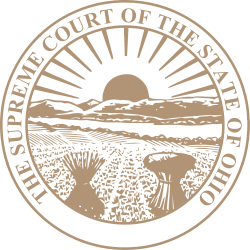- Supreme Court of Ohio
-
Ohio Supreme Court 
Seal of the Supreme Court of OhioEstablished 1841 Jurisdiction Ohio  , United States
, United States 
Location Columbus, Ohio Composition method Semipartisan election Authorized by Ohio Constitution Decisions are appealed to Supreme Court of the United States Judge term length 6 Years Number of positions 7 Website Official Website Chief Justice Currently Maureen O'Connor Since 2003 (Associate Justice) 2011 (Chief Justice) Lead position ends 2017 Jurist term ends 2017 The Supreme Court of Ohio is the highest court in the U.S. state of Ohio, with final authority over interpretations of Ohio law and the Ohio Constitution. The court has seven members, a chief justice and six associate justices, each serving six-year terms. Since 2004, the court has met in the Ohio Judicial Center (formerly known as the Ohio Departments Building) on the east bank of the Scioto River in downtown Columbus. Prior to 2004, the court met in the James A. Rhodes State Office Tower and earlier in the Judiciary Annex (now the Senate Building) of the Ohio Statehouse.
The Ohio Supreme Court and the rest of the judiciary is established and authorized within Article IV of the Ohio Constitution.
Contents
Justices
All the seats on the court are elected at large by the voters of Ohio. Every two years, two of the associate justice seats are up for election. For one of those three elections in a cycle, the chief justice's seat is up for election. In order to run for a seat on the court, a person must be admitted to the Bar in Ohio, and have practiced as a lawyer or served as a judge for at least six years.[1] There is an age limit: One may not run for a seat on any Ohio court if one is more than 70 years of age. This limit often forces the retirement of long-time justices. Justice Francis E. Sweeney Sr. was barred by this rule from running for re-election in 2004. However, a judge who reaches the age of 70 is not prevented from completing his term in office.
The Governor of Ohio may appoint a Justice to the Court when there is a vacancy.
Officially, the judicial elections are non-partisan. However, in practical terms, all this means is that party designations for the candidates are left off the ballot and justices are restricted in making public political statements. Major and minor parties all nominate candidates for the court in their primary elections. The vast majority of justices have been nominated by the two major parties in Ohio, Democratic or Republican. Many of the individuals who have contested Supreme Court seats have also contested for explicitly partisan political offices, both state and federal.
From the election of Justice Robert R. Cupp in November 2006 to replace Democrat Alice Robie Resnick until the 2010 appointment of Eric Brown as Chief Justice, the Court was all Republican.
Justice Born Date Service Began Term Ends Mandatory Retirement Maureen O'Connor (Chief Justice) 1951 Associate Justice-January 1, 2003
Chief Justice-January 1, 2011December 31, 2017 2021 Paul E. Pfeifer 1942 January 2, 1993 December 31, 2017 2012* Evelyn Lundberg Stratton 1953 March 7, 1996 December 31, 2014 2023 Terrence O'Donnell 1946 May 19, 2003 December 31, 2012 2016 Judith Ann Lanzinger 1946 January 1, 2005 December 31, 2017 2016* Robert R. Cupp 1951 January 2, 2007 December 31, 2012 2021 Yvette McGee Brown 1960 January 1, 2011 December 31, 2012 2030 Asterisks (*) next to retirement date indicate that the justice will be permitted to complete their current term, but will be barred from running for reelection due to having exceeded the mandatory retirement age (70 years old).
- In the court's history, there have been three instances where the female justice have outnumbered the male justices. The first occurred from January to May 2003, when the female majority comprised Republicans Deborah L. Cook, Maureen O'Connor, Evelyn Lundberg Stratton, and Democrat Alice Robie Resnick. The second time this occurred in 2005 and 2006. The third time was beginning in January 2011 under the current configuration of the court.
Important cases
In DeRolph v. State a case originating in the Perry County Schools it was decided that the state method of School Funding was unconstitutional.
Compensation
Name Job description Wages Overtime Year Maureen O'Connor judge $148,258.00 $0.00 2010 Paul E. Pfeifer judge $146,624.00 $0.00 2010 Terrence O'Donnell judge $148,258.00 $0.00 2010 Evelyn Lundberg Stratton judge $146,624.00 $0.00 2010 Robert R. Cupp judge $148,258.00 $0.00 2010 Judith A. Lanzinger judge $148,258.00 $0.00 2010 Yvette McGee Brown judge not reported $0.00 2010 The data contained in the table maybe verified by the interested reader at the Buckeye Institute web page. Please look at http://www.buckeyeinstitute.org/state-salary Select the judiciary category for which there are about 12,500 entries on 24 pages. If desired one can approximate the name of the individual and thus get a brief more targeted result.
See also
- Chief Justice of the Ohio Supreme Court
- Election Results, Ohio Supreme Court
- List of Justices of the Ohio Supreme Court
- List of Ohio politicians
- List of Ohio politicians (by state office)
- Ohio District Courts of Appeal
- Ohio Seventh District Court of Appeals
References
- ^ Ohio Revised Code § 2503.01
External links
Coordinates: 39°57′37″N 83°00′09″W / 39.960358°N 83.002487°W
Current elected statewide political officials of Ohio U.S. Senators 
State government - John Kasich, Governor
- Mary Taylor, Lieutenant Governor
- Jon A. Husted, Secretary of State
- Mike DeWine, Attorney General
- Dave Yost, State Auditor
- Josh Mandel, Treasurer
Senate - Tom Niehaus, President
- Keith Faber, President pro tempore
- Vacant, Majority Leader
- Capri Cafaro, Minority Leader
House - William G. Batchelder, Speaker
- Lou Blessing, Speaker pro tempore
- Matt Huffman, Majority Leader
- Armond Budish, Minority Leader
Supreme Court - Maureen O'Connor, Chief Justice
- Paul Pfeifer
- Evelyn Lundberg Stratton
- Terrence O'Donnell
- Judith Ann Lanzinger
- Robert R. Cupp
- Yvette McGee Brown
- AL
- AK
- AZ
- AR
- CA
- CO
- CT
- DE
- FL
- GA
- HI
- ID
- IL
- IN
- IA
- KS
- KY
- LA
- ME
- MD
- MA
- MI
- MN
- MS
- MO
- MT
- NE
- NV
- NH
- NJ
- NM
- NY
- NC
- ND
- OH
- OK
- OR
- PA
- RI
- SC
- SD
- TN
- TX
- UT
- VT
- VA
- WA
- WV
- WI
- WY
Highest judicial bodies in the United States Federal court State supreme courts Alabama · Alaska · Arizona · Arkansas · California · Colorado · Connecticut · Delaware · Florida · Georgia · Hawaii · Idaho · Illinois · Indiana · Iowa · Kansas · Kentucky · Louisiana · Maine · Maryland · Massachusetts · Michigan · Minnesota · Mississippi · Missouri · Montana · Nebraska · Nevada · New Hampshire · New Jersey · New Mexico · New York · North Carolina · North Dakota · Ohio · Oklahoma (Civil) (Criminal) · Oregon · Pennsylvania · Rhode Island · South Carolina · South Dakota · Tennessee · Texas (Civil) (Criminal) · Utah · Vermont · Virginia · Washington · West Virginia · Wisconsin · WyomingTerritorial supreme courts Obsolete Complete list Courts of the United States (Federal and state, all levels)Categories:- Ohio state courts
- State supreme courts
- Ohio Supreme Court
Wikimedia Foundation. 2010.

